Introduction to sensAI: Supervised Learning with VectorModels#
Show code cell content
%load_ext autoreload
%autoreload 2
Show code cell content
import sys
sys.path.append("../src")
import sensai
import numpy as np
Logging#
sensAI will log relevant activies and inform about ongoing processes as well as results via the log. It is therefore highly recommended that logging be enabled when using sensAI.
sensAI provides a logging module which includes Python’s standard logging module and adds some additional functionality. To enable logging, simply use its configureLogging function.
from sensai.util import logging
logging.configure(level=logging.INFO)
To additionally write log output to a file, use the function logging.add_file_logger.
VectorModels#
The central base class for supervised learning problems in sensAI is VectorModel. A VectorModel is any model which operates on data points that can be reprsented as vectors of data. Here, vector is to be understood not in the mathematical sense but in the computer science sense, where a vector is simply an array of (potentially arbitaririly complex) data. (The mathematical equivalent is a tuple.) Models are typically expected to be able to process more than one data point at a time and thus should be able to process a sequence of vectors.
We use pandas DataFrames to represent such sequences of data points. Note that pandas DataFrames are not limited to primitive data types but can hold arbitrary objects in every cell. When dealing with a large number of inputs, DataFrames also provide at least limited meta-information in the form of column names, so we do not lose track of what is contained in which element of a data point (vector).
VectorModel itself is an abstract base class, which provides a lot of useful functionality that all its specialisations inherit (as we will see later, particularly in the more advanced tutorials). The class is specialised in VectorClassificationModel and VectorRegressionModel, which in turn are specialised for various machine learning frameworks (such as sklearn and PyTorch) or can be directly subclassed to create your own model.
In this tutorial, we will be dealing with a classification problem. Therefore, we will apply subclasses of VectorClassificationModel such as SkLearnRandomForestVectorClassificationModel. As an sklearn classification model which uses a well-defined training and inference interface, the implementation of the class is essentially justa few lines of code (given the intermediate abstraction AbstractSkLearnVectorClassificationModel for all classification models that use the sklearn protocol).
Training and Evaluating Models#
First, let us load a dataset which we can experiment. sklearn provides, for example, the Iris classification dataset, where the task is to differentiate three different types of flowers based on measurements of their petals and sepals.
import sklearn.datasets
import pandas as pd
iris_data = sklearn.datasets.load_iris()
iris_input_df = pd.DataFrame(iris_data["data"], columns=iris_data["feature_names"]).reset_index(drop=True)
iris_output_df = pd.DataFrame({"class": [iris_data["target_names"][idx] for idx in iris_data["target"]]}).reset_index(drop=True)
Here’s a sample of the data, combining both the inputs and outputs:
iris_combined_df = pd.concat((iris_input_df, iris_output_df), axis=1)
iris_combined_df.sample(10)
| sepal length (cm) | sepal width (cm) | petal length (cm) | petal width (cm) | class | |
|---|---|---|---|---|---|
| 12 | 4.8 | 3.0 | 1.4 | 0.1 | setosa |
| 31 | 5.4 | 3.4 | 1.5 | 0.4 | setosa |
| 11 | 4.8 | 3.4 | 1.6 | 0.2 | setosa |
| 149 | 5.9 | 3.0 | 5.1 | 1.8 | virginica |
| 98 | 5.1 | 2.5 | 3.0 | 1.1 | versicolor |
| 43 | 5.0 | 3.5 | 1.6 | 0.6 | setosa |
| 44 | 5.1 | 3.8 | 1.9 | 0.4 | setosa |
| 1 | 4.9 | 3.0 | 1.4 | 0.2 | setosa |
| 50 | 7.0 | 3.2 | 4.7 | 1.4 | versicolor |
| 66 | 5.6 | 3.0 | 4.5 | 1.5 | versicolor |
When working with sensAI, we typically use DataFrames such as this as the starting point.
We create an instance of InputOutputData from the two data frames.
iris_io_data = sensai.InputOutputData(iris_input_df, iris_output_df)
Low-Level Training and Inference#
We use a DataSplitter (see subclasses) to split the data into a training and test set, specifically a DataSplitterFractional.
data_splitter = sensai.data.DataSplitterFractional(0.8, shuffle=True)
training_io_data, test_io_data = data_splitter.split(iris_io_data)
Now we are ready to train a model. Let us train a random forest classifier, which should work well for this sort of problem. sensAI provides models from various libraries, including scikit-learn, PyTorch, lightgbm, xgboost, catboost, and TensorFlow.
In this case, let us use the random forest implementation from sklearn, which is provided via the wrapper class SkLearnRandomForestVectorClassificationModel.
sensAI’s VectorModel classes (specialised for classification and regression) provide a common interface with a lot of useful functionality, which we will see later.
random_forest_model = sensai.sklearn.classification.SkLearnRandomForestVectorClassificationModel(
min_samples_leaf=2).with_name("RandomForest")
The class suppports all the parameters supported by the original sklearn model. In this case, we only set the minimum number of samples that must end up in each leaf.
We train the model using the fitInputOutputData method; we could also use the fit method, which is analogous to the sklearn interface and takes two arguments (input, output).
random_forest_model.fit_input_output_data(training_io_data)
random_forest_model
INFO 2025-04-06 23:33:18,699 sensai.vector_model:fit:359 - Fitting SkLearnRandomForestVectorClassificationModel instance
INFO 2025-04-06 23:33:18,701 sensai.sklearn.sklearn_base:_fit_classifier:314 - Fitting sklearn classifier of type RandomForestClassifier
INFO 2025-04-06 23:33:18,807 sensai.vector_model:fit:388 - Fitting completed in 0.11 seconds: SkLearnRandomForestVectorClassificationModel[featureGenerator=None, rawInputTransformerChain=DataFrameTransformerChain[dataFrameTransformers=[]], featureTransformerChain=DataFrameTransformerChain[dataFrameTransformers=[]], fitArgs={}, useBalancedClassWeights=False, useLabelEncoding=False, name='RandomForest', model='RandomForestClassifier(min_samples_leaf=2, random_state=42)']
SkLearnRandomForestVectorClassificationModel[id=140482760762624, featureGenerator=None, rawInputTransformerChain=DataFrameTransformerChain[dataFrameTransformers=[]], featureTransformerChain=DataFrameTransformerChain[dataFrameTransformers=[]], fitArgs={}, useBalancedClassWeights=False, useLabelEncoding=False, name='RandomForest', model='RandomForestClassifier(min_samples_leaf=2, random_state=42)']
We can now apply the trained model and predict the outputs for the test set we reserved.
predicted_outputs_df = random_forest_model.predict(test_io_data.inputs)
predicted_outputs_df.head(5)
| class | |
|---|---|
| 91 | versicolor |
| 41 | setosa |
| 58 | versicolor |
| 90 | versicolor |
| 48 | setosa |
Let’s compare some of the predictions to the ground truth.
pd.concat((predicted_outputs_df.rename(columns={"class": "predictedClass"}), test_io_data.outputs), axis=1).sample(10)
| predictedClass | class | |
|---|---|---|
| 92 | versicolor | versicolor |
| 130 | virginica | virginica |
| 48 | setosa | setosa |
| 140 | virginica | virginica |
| 144 | virginica | virginica |
| 149 | virginica | virginica |
| 91 | versicolor | versicolor |
| 88 | versicolor | versicolor |
| 103 | virginica | virginica |
| 106 | versicolor | virginica |
Using the ground truth and predicted values, we could now compute the metrics we’re interested in. We could, for example, use the metrics implemented in sklearn to analyse the result. Yet sensAI already provides abstractions that facilitate the generation of metrics and the collection of results. Read on!
Using Evaluators#
sensAI provides evaluator abstractions which facilitate the training and evaluation of models.
For a classification problem, we instantiate a VectorClassificationModelEvaluator. An evaluator serves to evaluate one or more models based on the same data, so we construct it with the data and instructions on how to handle/split the data for evaluation.
evaluator_params = sensai.evaluation.ClassificationEvaluatorParams(data_splitter=data_splitter, compute_probabilities=True)
evaluator = sensai.evaluation.VectorClassificationModelEvaluator(iris_io_data, params=evaluator_params)
We can use this evaluator to evaluate one or more models. Let us evaluate the random forest model from above.
evaluator.fit_model(random_forest_model)
eval_data = evaluator.eval_model(random_forest_model)
INFO 2025-04-06 23:33:18,908 sensai.vector_model:fit:359 - Fitting SkLearnRandomForestVectorClassificationModel instance
INFO 2025-04-06 23:33:18,910 sensai.sklearn.sklearn_base:_fit_classifier:314 - Fitting sklearn classifier of type RandomForestClassifier
INFO 2025-04-06 23:33:19,016 sensai.vector_model:fit:388 - Fitting completed in 0.11 seconds: SkLearnRandomForestVectorClassificationModel[featureGenerator=None, rawInputTransformerChain=DataFrameTransformerChain[dataFrameTransformers=[]], featureTransformerChain=DataFrameTransformerChain[dataFrameTransformers=[]], fitArgs={}, useBalancedClassWeights=False, useLabelEncoding=False, name='RandomForest', model='RandomForestClassifier(min_samples_leaf=2, random_state=42)']
The evaluation data holds, in particular, an EvalStats object, which can provide data on the quality of the results. Depending on the type of problem, many metrics will already be computed by default.
eval_stats = eval_data.get_eval_stats()
eval_stats
ClassificationEvalStats[id=140481664863584, accuracy=0.9666666666666667, balancedAccuracy=0.9722222222222222, geoMeanTrueClassProb=0.8890980234758366, N=30]
We can get the metrics in a dictionary as follows:
eval_stats.metrics_dict()
{'accuracy': 0.9666666666666667,
'balancedAccuracy': np.float64(0.9722222222222222),
'geoMeanTrueClassProb': np.float64(0.8890980234758366)}
We can compute additional metrics by passing a metric to the compute_metric_value method, but we could also have added additional metrics to the evaluator_params above and have the metric included in all results.
Let’s see how frequently the true class is among the top two most probable classes.
eval_stats.compute_metric_value(sensai.eval_stats_classification.ClassificationMetricTopNAccuracy(2))
1.0
The EvalStats object can also be used to generate plots, such as a confusion matrix or a precision-recall plot for binary classification.
eval_stats.plot_confusion_matrix(normalize=True);
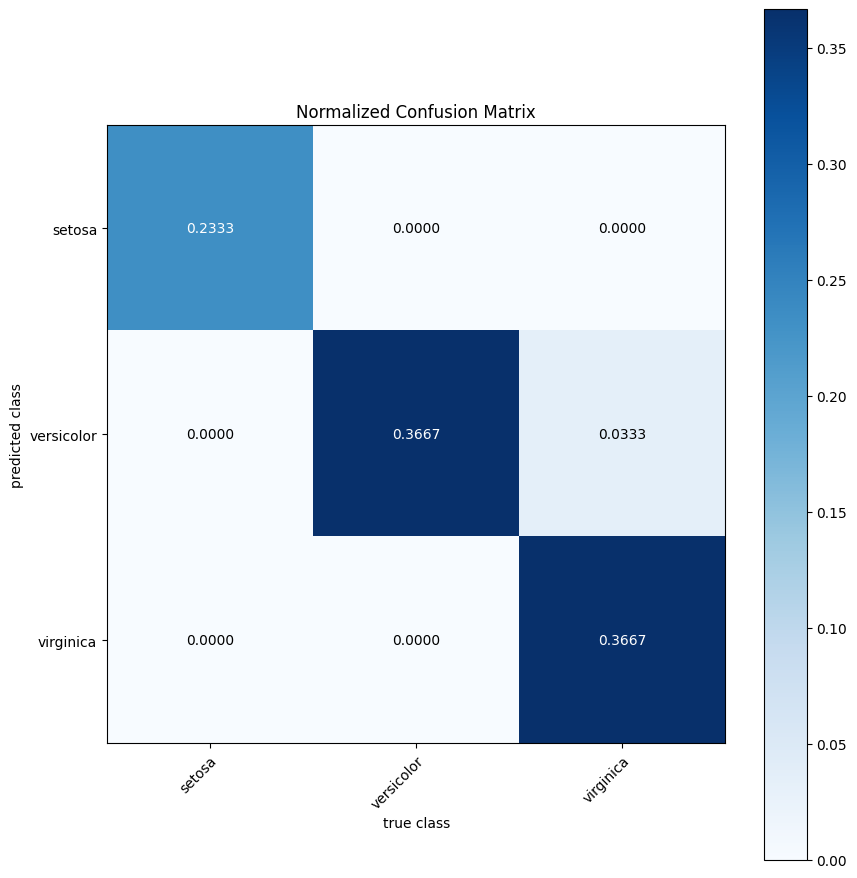
Using the Fully-Integrated Evaluation Utilities#
sensAI’s evaluation utilities take things one step further and assist you in out all the evaluation steps and results computations in a single call.
You can perform evaluations based on a single split or cross-validation. We simply declare the necessary parameters for both types of computations (or the one type we seek to carry out).
evaluatorParams = sensai.evaluation.ClassificationEvaluatorParams(
data_splitter=data_splitter, compute_probabilities=True,
additional_metrics=[sensai.eval_stats_classification.ClassificationMetricTopNAccuracy(2)])
cross_validator_params = sensai.evaluation.crossval.VectorModelCrossValidatorParams(folds=10,
evaluator_params=evaluator_params)
eval_util = sensai.evaluation.ClassificationModelEvaluation(iris_io_data,
evaluator_params=evaluatorParams, cross_validator_params=cross_validator_params)
In practice, we will usually want to save evaluation results. The evaluation methods of eval_util take a parameter result_writer which allows us to define where results shall be written. Within this notebook, we shall simply inspect the resulting metrics in the log that is printed, and we shall configure plots to be shown directly.
Simple Evaluation#
We can perform the same evaluation as above (which uses a single split) like so:
eval_util.perform_simple_evaluation(random_forest_model, show_plots=True)
INFO 2025-04-06 23:33:19,419 sensai.evaluation.eval_util:perform_simple_evaluation:287 - Evaluating SkLearnRandomForestVectorClassificationModel[featureGenerator=None, rawInputTransformerChain=DataFrameTransformerChain[dataFrameTransformers=[]], featureTransformerChain=DataFrameTransformerChain[dataFrameTransformers=[]], fitArgs={}, useBalancedClassWeights=False, useLabelEncoding=False, name='RandomForest', model='RandomForestClassifier(min_samples_leaf=2, random_state=42)'] via <sensai.evaluation.evaluator.VectorClassificationModelEvaluator object at 0x7fc4b10d6680>
INFO 2025-04-06 23:33:19,420 sensai.vector_model:fit:359 - Fitting SkLearnRandomForestVectorClassificationModel instance
INFO 2025-04-06 23:33:19,422 sensai.sklearn.sklearn_base:_fit_classifier:314 - Fitting sklearn classifier of type RandomForestClassifier
INFO 2025-04-06 23:33:19,527 sensai.vector_model:fit:388 - Fitting completed in 0.11 seconds: SkLearnRandomForestVectorClassificationModel[featureGenerator=None, rawInputTransformerChain=DataFrameTransformerChain[dataFrameTransformers=[]], featureTransformerChain=DataFrameTransformerChain[dataFrameTransformers=[]], fitArgs={}, useBalancedClassWeights=False, useLabelEncoding=False, name='RandomForest', model='RandomForestClassifier(min_samples_leaf=2, random_state=42)']
INFO 2025-04-06 23:33:19,540 sensai.evaluation.eval_util:gather_results:295 - Evaluation results for class: ClassificationEvalStats[accuracy=0.9666666666666667, balancedAccuracy=0.9722222222222222, geoMeanTrueClassProb=0.8890980234758366, top2Accuracy=1.0, N=30]
<sensai.evaluation.evaluator.VectorClassificationModelEvaluationData at 0x7fc46fbb58d0>
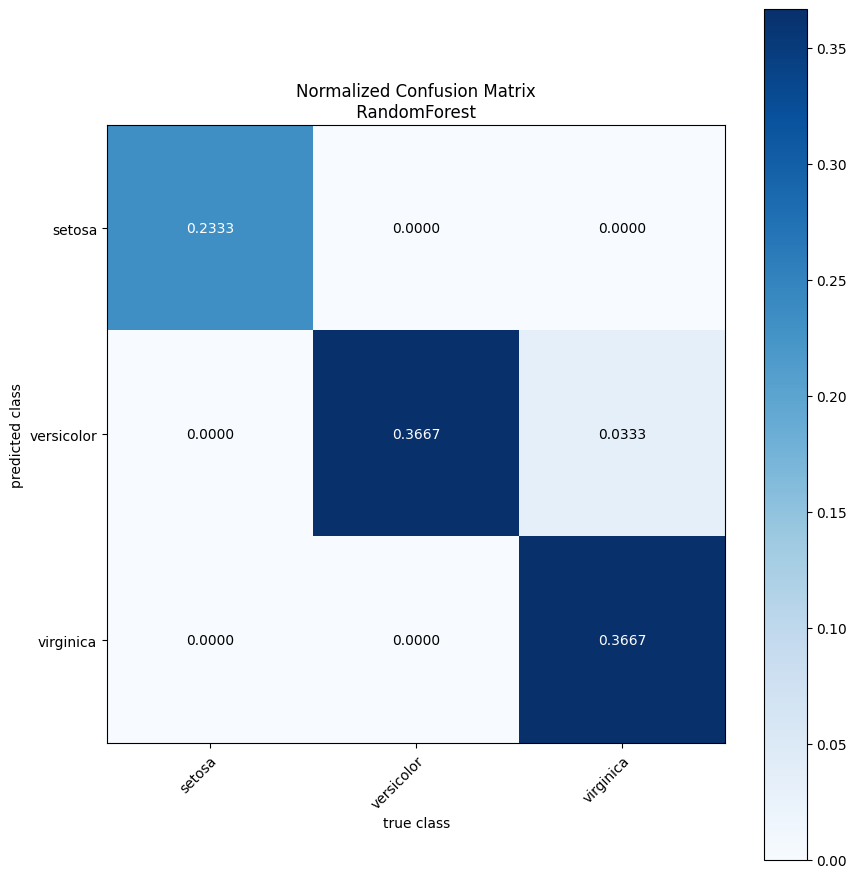
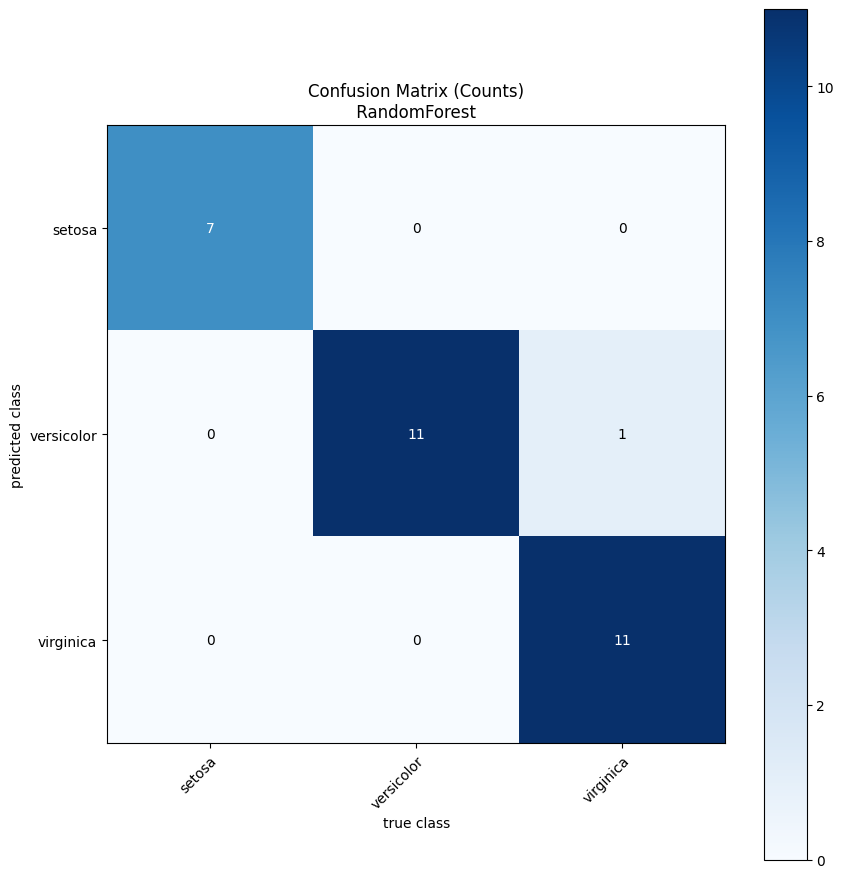
Customising the Set of Plots#
If we decide that we don’t really want to have the normalised confusion matrix, we can disable it for any further experiments.
eval_util.eval_stats_plot_collector.get_enabled_plots()
['confusion-matrix-rel',
'confusion-matrix-abs',
'precision-recall',
'threshold-precision-recall',
'threshold-counts']
Some of these are only active for binary classification. The one we don’t want is “confusion-matrix-rel”.
eval_util.eval_stats_plot_collector.disable_plots("confusion-matrix-rel")
We could also define our own plot class (by creating a new subclass of ClassificationEvalStatsPlot) and add it to the plot collector in order to have the plot auto-generated whenever we apply one of eval_util’s methods.
Cross-Validation#
We can similarly run cross-validation and produce the respective evaluation metrics with a single call.
eval_util.perform_cross_validation(random_forest_model, show_plots=True)
INFO 2025-04-06 23:33:20,006 sensai.evaluation.crossval:eval_model:192 - Training and evaluating model with fold 1/10 ...
INFO 2025-04-06 23:33:20,006 sensai.vector_model:fit:359 - Fitting SkLearnRandomForestVectorClassificationModel instance
INFO 2025-04-06 23:33:20,007 sensai.sklearn.sklearn_base:_fit_classifier:314 - Fitting sklearn classifier of type RandomForestClassifier
INFO 2025-04-06 23:33:20,114 sensai.vector_model:fit:388 - Fitting completed in 0.11 seconds: SkLearnRandomForestVectorClassificationModel[featureGenerator=None, rawInputTransformerChain=DataFrameTransformerChain[dataFrameTransformers=[]], featureTransformerChain=DataFrameTransformerChain[dataFrameTransformers=[]], fitArgs={}, useBalancedClassWeights=False, useLabelEncoding=False, name='RandomForest', model='RandomForestClassifier(min_samples_leaf=2, random_state=42)']
INFO 2025-04-06 23:33:20,129 sensai.evaluation.crossval:eval_model:201 - Evaluation result for class, fold 1/10: ClassificationEvalStats[accuracy=1.0, balancedAccuracy=1.0, geoMeanTrueClassProb=0.9553599022560102, N=15]
INFO 2025-04-06 23:33:20,130 sensai.evaluation.crossval:eval_model:192 - Training and evaluating model with fold 2/10 ...
INFO 2025-04-06 23:33:20,131 sensai.vector_model:fit:359 - Fitting SkLearnRandomForestVectorClassificationModel instance
INFO 2025-04-06 23:33:20,132 sensai.sklearn.sklearn_base:_fit_classifier:314 - Fitting sklearn classifier of type RandomForestClassifier
INFO 2025-04-06 23:33:20,238 sensai.vector_model:fit:388 - Fitting completed in 0.11 seconds: SkLearnRandomForestVectorClassificationModel[featureGenerator=None, rawInputTransformerChain=DataFrameTransformerChain[dataFrameTransformers=[]], featureTransformerChain=DataFrameTransformerChain[dataFrameTransformers=[]], fitArgs={}, useBalancedClassWeights=False, useLabelEncoding=False, name='RandomForest', model='RandomForestClassifier(min_samples_leaf=2, random_state=42)']
INFO 2025-04-06 23:33:20,253 sensai.evaluation.crossval:eval_model:201 - Evaluation result for class, fold 2/10: ClassificationEvalStats[accuracy=1.0, balancedAccuracy=1.0, geoMeanTrueClassProb=0.9734228107223192, N=15]
INFO 2025-04-06 23:33:20,253 sensai.evaluation.crossval:eval_model:192 - Training and evaluating model with fold 3/10 ...
INFO 2025-04-06 23:33:20,254 sensai.vector_model:fit:359 - Fitting SkLearnRandomForestVectorClassificationModel instance
INFO 2025-04-06 23:33:20,255 sensai.sklearn.sklearn_base:_fit_classifier:314 - Fitting sklearn classifier of type RandomForestClassifier
INFO 2025-04-06 23:33:20,361 sensai.vector_model:fit:388 - Fitting completed in 0.11 seconds: SkLearnRandomForestVectorClassificationModel[featureGenerator=None, rawInputTransformerChain=DataFrameTransformerChain[dataFrameTransformers=[]], featureTransformerChain=DataFrameTransformerChain[dataFrameTransformers=[]], fitArgs={}, useBalancedClassWeights=False, useLabelEncoding=False, name='RandomForest', model='RandomForestClassifier(min_samples_leaf=2, random_state=42)']
INFO 2025-04-06 23:33:20,374 sensai.evaluation.crossval:eval_model:201 - Evaluation result for class, fold 3/10: ClassificationEvalStats[accuracy=1.0, balancedAccuracy=1.0, geoMeanTrueClassProb=0.976458969438705, N=15]
INFO 2025-04-06 23:33:20,374 sensai.evaluation.crossval:eval_model:192 - Training and evaluating model with fold 4/10 ...
INFO 2025-04-06 23:33:20,375 sensai.vector_model:fit:359 - Fitting SkLearnRandomForestVectorClassificationModel instance
INFO 2025-04-06 23:33:20,376 sensai.sklearn.sklearn_base:_fit_classifier:314 - Fitting sklearn classifier of type RandomForestClassifier
INFO 2025-04-06 23:33:20,484 sensai.vector_model:fit:388 - Fitting completed in 0.11 seconds: SkLearnRandomForestVectorClassificationModel[featureGenerator=None, rawInputTransformerChain=DataFrameTransformerChain[dataFrameTransformers=[]], featureTransformerChain=DataFrameTransformerChain[dataFrameTransformers=[]], fitArgs={}, useBalancedClassWeights=False, useLabelEncoding=False, name='RandomForest', model='RandomForestClassifier(min_samples_leaf=2, random_state=42)']
INFO 2025-04-06 23:33:20,497 sensai.evaluation.crossval:eval_model:201 - Evaluation result for class, fold 4/10: ClassificationEvalStats[accuracy=0.9333333333333333, balancedAccuracy=0.9333333333333332, geoMeanTrueClassProb=0.9411926691126593, N=15]
INFO 2025-04-06 23:33:20,497 sensai.evaluation.crossval:eval_model:192 - Training and evaluating model with fold 5/10 ...
INFO 2025-04-06 23:33:20,498 sensai.vector_model:fit:359 - Fitting SkLearnRandomForestVectorClassificationModel instance
INFO 2025-04-06 23:33:20,499 sensai.sklearn.sklearn_base:_fit_classifier:314 - Fitting sklearn classifier of type RandomForestClassifier
INFO 2025-04-06 23:33:20,606 sensai.vector_model:fit:388 - Fitting completed in 0.11 seconds: SkLearnRandomForestVectorClassificationModel[featureGenerator=None, rawInputTransformerChain=DataFrameTransformerChain[dataFrameTransformers=[]], featureTransformerChain=DataFrameTransformerChain[dataFrameTransformers=[]], fitArgs={}, useBalancedClassWeights=False, useLabelEncoding=False, name='RandomForest', model='RandomForestClassifier(min_samples_leaf=2, random_state=42)']
INFO 2025-04-06 23:33:20,620 sensai.evaluation.crossval:eval_model:201 - Evaluation result for class, fold 5/10: ClassificationEvalStats[accuracy=1.0, balancedAccuracy=1.0, geoMeanTrueClassProb=0.9298964965102043, N=15]
INFO 2025-04-06 23:33:20,620 sensai.evaluation.crossval:eval_model:192 - Training and evaluating model with fold 6/10 ...
INFO 2025-04-06 23:33:20,621 sensai.vector_model:fit:359 - Fitting SkLearnRandomForestVectorClassificationModel instance
INFO 2025-04-06 23:33:20,622 sensai.sklearn.sklearn_base:_fit_classifier:314 - Fitting sklearn classifier of type RandomForestClassifier
INFO 2025-04-06 23:33:20,728 sensai.vector_model:fit:388 - Fitting completed in 0.11 seconds: SkLearnRandomForestVectorClassificationModel[featureGenerator=None, rawInputTransformerChain=DataFrameTransformerChain[dataFrameTransformers=[]], featureTransformerChain=DataFrameTransformerChain[dataFrameTransformers=[]], fitArgs={}, useBalancedClassWeights=False, useLabelEncoding=False, name='RandomForest', model='RandomForestClassifier(min_samples_leaf=2, random_state=42)']
INFO 2025-04-06 23:33:20,742 sensai.evaluation.crossval:eval_model:201 - Evaluation result for class, fold 6/10: ClassificationEvalStats[accuracy=0.8666666666666667, balancedAccuracy=0.8888888888888888, geoMeanTrueClassProb=0.6379522029160006, N=15]
INFO 2025-04-06 23:33:20,743 sensai.evaluation.crossval:eval_model:192 - Training and evaluating model with fold 7/10 ...
INFO 2025-04-06 23:33:20,743 sensai.vector_model:fit:359 - Fitting SkLearnRandomForestVectorClassificationModel instance
INFO 2025-04-06 23:33:20,745 sensai.sklearn.sklearn_base:_fit_classifier:314 - Fitting sklearn classifier of type RandomForestClassifier
INFO 2025-04-06 23:33:20,850 sensai.vector_model:fit:388 - Fitting completed in 0.11 seconds: SkLearnRandomForestVectorClassificationModel[featureGenerator=None, rawInputTransformerChain=DataFrameTransformerChain[dataFrameTransformers=[]], featureTransformerChain=DataFrameTransformerChain[dataFrameTransformers=[]], fitArgs={}, useBalancedClassWeights=False, useLabelEncoding=False, name='RandomForest', model='RandomForestClassifier(min_samples_leaf=2, random_state=42)']
INFO 2025-04-06 23:33:20,864 sensai.evaluation.crossval:eval_model:201 - Evaluation result for class, fold 7/10: ClassificationEvalStats[accuracy=0.8666666666666667, balancedAccuracy=0.8611111111111112, geoMeanTrueClassProb=0.8099785263057822, N=15]
INFO 2025-04-06 23:33:20,864 sensai.evaluation.crossval:eval_model:192 - Training and evaluating model with fold 8/10 ...
INFO 2025-04-06 23:33:20,865 sensai.vector_model:fit:359 - Fitting SkLearnRandomForestVectorClassificationModel instance
INFO 2025-04-06 23:33:20,866 sensai.sklearn.sklearn_base:_fit_classifier:314 - Fitting sklearn classifier of type RandomForestClassifier
INFO 2025-04-06 23:33:20,973 sensai.vector_model:fit:388 - Fitting completed in 0.11 seconds: SkLearnRandomForestVectorClassificationModel[featureGenerator=None, rawInputTransformerChain=DataFrameTransformerChain[dataFrameTransformers=[]], featureTransformerChain=DataFrameTransformerChain[dataFrameTransformers=[]], fitArgs={}, useBalancedClassWeights=False, useLabelEncoding=False, name='RandomForest', model='RandomForestClassifier(min_samples_leaf=2, random_state=42)']
INFO 2025-04-06 23:33:20,988 sensai.evaluation.crossval:eval_model:201 - Evaluation result for class, fold 8/10: ClassificationEvalStats[accuracy=1.0, balancedAccuracy=1.0, geoMeanTrueClassProb=0.9657414983648998, N=15]
INFO 2025-04-06 23:33:20,989 sensai.evaluation.crossval:eval_model:192 - Training and evaluating model with fold 9/10 ...
INFO 2025-04-06 23:33:20,989 sensai.vector_model:fit:359 - Fitting SkLearnRandomForestVectorClassificationModel instance
INFO 2025-04-06 23:33:20,990 sensai.sklearn.sklearn_base:_fit_classifier:314 - Fitting sklearn classifier of type RandomForestClassifier
INFO 2025-04-06 23:33:21,096 sensai.vector_model:fit:388 - Fitting completed in 0.11 seconds: SkLearnRandomForestVectorClassificationModel[featureGenerator=None, rawInputTransformerChain=DataFrameTransformerChain[dataFrameTransformers=[]], featureTransformerChain=DataFrameTransformerChain[dataFrameTransformers=[]], fitArgs={}, useBalancedClassWeights=False, useLabelEncoding=False, name='RandomForest', model='RandomForestClassifier(min_samples_leaf=2, random_state=42)']
INFO 2025-04-06 23:33:21,109 sensai.evaluation.crossval:eval_model:201 - Evaluation result for class, fold 9/10: ClassificationEvalStats[accuracy=1.0, balancedAccuracy=1.0, geoMeanTrueClassProb=0.9560552426688266, N=15]
INFO 2025-04-06 23:33:21,109 sensai.evaluation.crossval:eval_model:192 - Training and evaluating model with fold 10/10 ...
INFO 2025-04-06 23:33:21,111 sensai.vector_model:fit:359 - Fitting SkLearnRandomForestVectorClassificationModel instance
INFO 2025-04-06 23:33:21,112 sensai.sklearn.sklearn_base:_fit_classifier:314 - Fitting sklearn classifier of type RandomForestClassifier
INFO 2025-04-06 23:33:21,217 sensai.vector_model:fit:388 - Fitting completed in 0.11 seconds: SkLearnRandomForestVectorClassificationModel[featureGenerator=None, rawInputTransformerChain=DataFrameTransformerChain[dataFrameTransformers=[]], featureTransformerChain=DataFrameTransformerChain[dataFrameTransformers=[]], fitArgs={}, useBalancedClassWeights=False, useLabelEncoding=False, name='RandomForest', model='RandomForestClassifier(min_samples_leaf=2, random_state=42)']
INFO 2025-04-06 23:33:21,230 sensai.evaluation.crossval:eval_model:201 - Evaluation result for class, fold 10/10: ClassificationEvalStats[accuracy=0.9333333333333333, balancedAccuracy=0.9523809523809524, geoMeanTrueClassProb=0.841736920530503, N=15]
INFO 2025-04-06 23:33:21,246 sensai.evaluation.eval_util:perform_cross_validation:350 - Cross-validation results:
mean[accuracy] std[accuracy] mean[balancedAccuracy] std[balancedAccuracy] mean[geoMeanTrueClassProb] std[geoMeanTrueClassProb]
class 0.96 0.053333 0.963571 0.050077 0.89878 0.10223
<sensai.evaluation.crossval.VectorClassificationModelCrossValidationData at 0x7fc46f8a5f30>
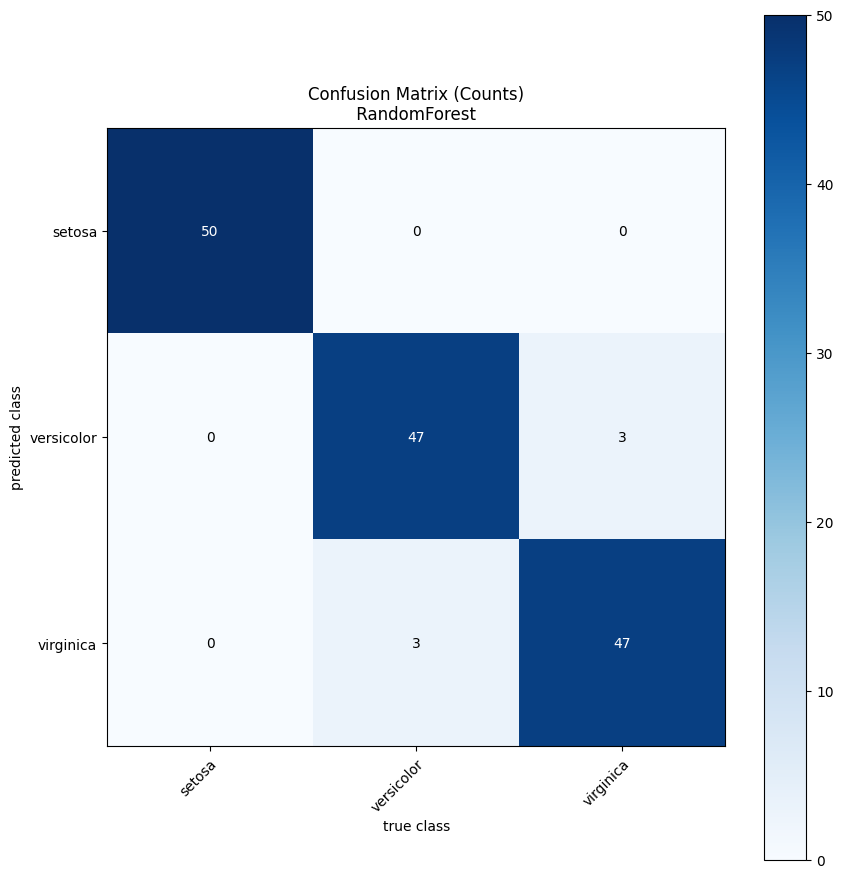
As you can see, the plot we disabled earlier is no longer being generated.
Comparing Models#
A most common use case is to compare the performance of several models. The evaluation utility makes it very simple to compare any number of models.
Let’s say we want to compare the random forest we have been using thus far to a simple decision tree.
results = eval_util.compare_models([
random_forest_model,
sensai.sklearn.classification.SkLearnDecisionTreeVectorClassificationModel(min_samples_leaf=2).with_name("DecisionTree")],
use_cross_validation=True)
INFO 2025-04-06 23:33:21,552 sensai.evaluation.eval_util:compare_models:399 - Evaluating model 1/2 named 'RandomForest' ...
INFO 2025-04-06 23:33:21,556 sensai.evaluation.crossval:eval_model:192 - Training and evaluating model with fold 1/10 ...
INFO 2025-04-06 23:33:21,557 sensai.vector_model:fit:359 - Fitting SkLearnRandomForestVectorClassificationModel instance
INFO 2025-04-06 23:33:21,558 sensai.sklearn.sklearn_base:_fit_classifier:314 - Fitting sklearn classifier of type RandomForestClassifier
INFO 2025-04-06 23:33:21,664 sensai.vector_model:fit:388 - Fitting completed in 0.11 seconds: SkLearnRandomForestVectorClassificationModel[featureGenerator=None, rawInputTransformerChain=DataFrameTransformerChain[dataFrameTransformers=[]], featureTransformerChain=DataFrameTransformerChain[dataFrameTransformers=[]], fitArgs={}, useBalancedClassWeights=False, useLabelEncoding=False, name='RandomForest', model='RandomForestClassifier(min_samples_leaf=2, random_state=42)']
INFO 2025-04-06 23:33:21,679 sensai.evaluation.crossval:eval_model:201 - Evaluation result for class, fold 1/10: ClassificationEvalStats[accuracy=1.0, balancedAccuracy=1.0, geoMeanTrueClassProb=0.9553599022560102, N=15]
INFO 2025-04-06 23:33:21,680 sensai.evaluation.crossval:eval_model:192 - Training and evaluating model with fold 2/10 ...
INFO 2025-04-06 23:33:21,680 sensai.vector_model:fit:359 - Fitting SkLearnRandomForestVectorClassificationModel instance
INFO 2025-04-06 23:33:21,681 sensai.sklearn.sklearn_base:_fit_classifier:314 - Fitting sklearn classifier of type RandomForestClassifier
INFO 2025-04-06 23:33:21,788 sensai.vector_model:fit:388 - Fitting completed in 0.11 seconds: SkLearnRandomForestVectorClassificationModel[featureGenerator=None, rawInputTransformerChain=DataFrameTransformerChain[dataFrameTransformers=[]], featureTransformerChain=DataFrameTransformerChain[dataFrameTransformers=[]], fitArgs={}, useBalancedClassWeights=False, useLabelEncoding=False, name='RandomForest', model='RandomForestClassifier(min_samples_leaf=2, random_state=42)']
INFO 2025-04-06 23:33:21,800 sensai.evaluation.crossval:eval_model:201 - Evaluation result for class, fold 2/10: ClassificationEvalStats[accuracy=1.0, balancedAccuracy=1.0, geoMeanTrueClassProb=0.9734228107223192, N=15]
INFO 2025-04-06 23:33:21,801 sensai.evaluation.crossval:eval_model:192 - Training and evaluating model with fold 3/10 ...
INFO 2025-04-06 23:33:21,801 sensai.vector_model:fit:359 - Fitting SkLearnRandomForestVectorClassificationModel instance
INFO 2025-04-06 23:33:21,803 sensai.sklearn.sklearn_base:_fit_classifier:314 - Fitting sklearn classifier of type RandomForestClassifier
INFO 2025-04-06 23:33:21,907 sensai.vector_model:fit:388 - Fitting completed in 0.10 seconds: SkLearnRandomForestVectorClassificationModel[featureGenerator=None, rawInputTransformerChain=DataFrameTransformerChain[dataFrameTransformers=[]], featureTransformerChain=DataFrameTransformerChain[dataFrameTransformers=[]], fitArgs={}, useBalancedClassWeights=False, useLabelEncoding=False, name='RandomForest', model='RandomForestClassifier(min_samples_leaf=2, random_state=42)']
INFO 2025-04-06 23:33:21,923 sensai.evaluation.crossval:eval_model:201 - Evaluation result for class, fold 3/10: ClassificationEvalStats[accuracy=1.0, balancedAccuracy=1.0, geoMeanTrueClassProb=0.976458969438705, N=15]
INFO 2025-04-06 23:33:21,923 sensai.evaluation.crossval:eval_model:192 - Training and evaluating model with fold 4/10 ...
INFO 2025-04-06 23:33:21,924 sensai.vector_model:fit:359 - Fitting SkLearnRandomForestVectorClassificationModel instance
INFO 2025-04-06 23:33:21,926 sensai.sklearn.sklearn_base:_fit_classifier:314 - Fitting sklearn classifier of type RandomForestClassifier
INFO 2025-04-06 23:33:22,031 sensai.vector_model:fit:388 - Fitting completed in 0.11 seconds: SkLearnRandomForestVectorClassificationModel[featureGenerator=None, rawInputTransformerChain=DataFrameTransformerChain[dataFrameTransformers=[]], featureTransformerChain=DataFrameTransformerChain[dataFrameTransformers=[]], fitArgs={}, useBalancedClassWeights=False, useLabelEncoding=False, name='RandomForest', model='RandomForestClassifier(min_samples_leaf=2, random_state=42)']
INFO 2025-04-06 23:33:22,047 sensai.evaluation.crossval:eval_model:201 - Evaluation result for class, fold 4/10: ClassificationEvalStats[accuracy=0.9333333333333333, balancedAccuracy=0.9333333333333332, geoMeanTrueClassProb=0.9411926691126593, N=15]
INFO 2025-04-06 23:33:22,047 sensai.evaluation.crossval:eval_model:192 - Training and evaluating model with fold 5/10 ...
INFO 2025-04-06 23:33:22,048 sensai.vector_model:fit:359 - Fitting SkLearnRandomForestVectorClassificationModel instance
INFO 2025-04-06 23:33:22,049 sensai.sklearn.sklearn_base:_fit_classifier:314 - Fitting sklearn classifier of type RandomForestClassifier
INFO 2025-04-06 23:33:22,155 sensai.vector_model:fit:388 - Fitting completed in 0.11 seconds: SkLearnRandomForestVectorClassificationModel[featureGenerator=None, rawInputTransformerChain=DataFrameTransformerChain[dataFrameTransformers=[]], featureTransformerChain=DataFrameTransformerChain[dataFrameTransformers=[]], fitArgs={}, useBalancedClassWeights=False, useLabelEncoding=False, name='RandomForest', model='RandomForestClassifier(min_samples_leaf=2, random_state=42)']
INFO 2025-04-06 23:33:22,170 sensai.evaluation.crossval:eval_model:201 - Evaluation result for class, fold 5/10: ClassificationEvalStats[accuracy=1.0, balancedAccuracy=1.0, geoMeanTrueClassProb=0.9298964965102043, N=15]
INFO 2025-04-06 23:33:22,171 sensai.evaluation.crossval:eval_model:192 - Training and evaluating model with fold 6/10 ...
INFO 2025-04-06 23:33:22,172 sensai.vector_model:fit:359 - Fitting SkLearnRandomForestVectorClassificationModel instance
INFO 2025-04-06 23:33:22,173 sensai.sklearn.sklearn_base:_fit_classifier:314 - Fitting sklearn classifier of type RandomForestClassifier
INFO 2025-04-06 23:33:22,279 sensai.vector_model:fit:388 - Fitting completed in 0.11 seconds: SkLearnRandomForestVectorClassificationModel[featureGenerator=None, rawInputTransformerChain=DataFrameTransformerChain[dataFrameTransformers=[]], featureTransformerChain=DataFrameTransformerChain[dataFrameTransformers=[]], fitArgs={}, useBalancedClassWeights=False, useLabelEncoding=False, name='RandomForest', model='RandomForestClassifier(min_samples_leaf=2, random_state=42)']
INFO 2025-04-06 23:33:22,294 sensai.evaluation.crossval:eval_model:201 - Evaluation result for class, fold 6/10: ClassificationEvalStats[accuracy=0.8666666666666667, balancedAccuracy=0.8888888888888888, geoMeanTrueClassProb=0.6379522029160006, N=15]
INFO 2025-04-06 23:33:22,294 sensai.evaluation.crossval:eval_model:192 - Training and evaluating model with fold 7/10 ...
INFO 2025-04-06 23:33:22,295 sensai.vector_model:fit:359 - Fitting SkLearnRandomForestVectorClassificationModel instance
INFO 2025-04-06 23:33:22,296 sensai.sklearn.sklearn_base:_fit_classifier:314 - Fitting sklearn classifier of type RandomForestClassifier
INFO 2025-04-06 23:33:22,401 sensai.vector_model:fit:388 - Fitting completed in 0.11 seconds: SkLearnRandomForestVectorClassificationModel[featureGenerator=None, rawInputTransformerChain=DataFrameTransformerChain[dataFrameTransformers=[]], featureTransformerChain=DataFrameTransformerChain[dataFrameTransformers=[]], fitArgs={}, useBalancedClassWeights=False, useLabelEncoding=False, name='RandomForest', model='RandomForestClassifier(min_samples_leaf=2, random_state=42)']
INFO 2025-04-06 23:33:22,415 sensai.evaluation.crossval:eval_model:201 - Evaluation result for class, fold 7/10: ClassificationEvalStats[accuracy=0.8666666666666667, balancedAccuracy=0.8611111111111112, geoMeanTrueClassProb=0.8099785263057822, N=15]
INFO 2025-04-06 23:33:22,415 sensai.evaluation.crossval:eval_model:192 - Training and evaluating model with fold 8/10 ...
INFO 2025-04-06 23:33:22,416 sensai.vector_model:fit:359 - Fitting SkLearnRandomForestVectorClassificationModel instance
INFO 2025-04-06 23:33:22,417 sensai.sklearn.sklearn_base:_fit_classifier:314 - Fitting sklearn classifier of type RandomForestClassifier
INFO 2025-04-06 23:33:22,529 sensai.vector_model:fit:388 - Fitting completed in 0.11 seconds: SkLearnRandomForestVectorClassificationModel[featureGenerator=None, rawInputTransformerChain=DataFrameTransformerChain[dataFrameTransformers=[]], featureTransformerChain=DataFrameTransformerChain[dataFrameTransformers=[]], fitArgs={}, useBalancedClassWeights=False, useLabelEncoding=False, name='RandomForest', model='RandomForestClassifier(min_samples_leaf=2, random_state=42)']
INFO 2025-04-06 23:33:22,542 sensai.evaluation.crossval:eval_model:201 - Evaluation result for class, fold 8/10: ClassificationEvalStats[accuracy=1.0, balancedAccuracy=1.0, geoMeanTrueClassProb=0.9657414983648998, N=15]
INFO 2025-04-06 23:33:22,542 sensai.evaluation.crossval:eval_model:192 - Training and evaluating model with fold 9/10 ...
INFO 2025-04-06 23:33:22,543 sensai.vector_model:fit:359 - Fitting SkLearnRandomForestVectorClassificationModel instance
INFO 2025-04-06 23:33:22,544 sensai.sklearn.sklearn_base:_fit_classifier:314 - Fitting sklearn classifier of type RandomForestClassifier
INFO 2025-04-06 23:33:22,650 sensai.vector_model:fit:388 - Fitting completed in 0.11 seconds: SkLearnRandomForestVectorClassificationModel[featureGenerator=None, rawInputTransformerChain=DataFrameTransformerChain[dataFrameTransformers=[]], featureTransformerChain=DataFrameTransformerChain[dataFrameTransformers=[]], fitArgs={}, useBalancedClassWeights=False, useLabelEncoding=False, name='RandomForest', model='RandomForestClassifier(min_samples_leaf=2, random_state=42)']
INFO 2025-04-06 23:33:22,665 sensai.evaluation.crossval:eval_model:201 - Evaluation result for class, fold 9/10: ClassificationEvalStats[accuracy=1.0, balancedAccuracy=1.0, geoMeanTrueClassProb=0.9560552426688266, N=15]
INFO 2025-04-06 23:33:22,666 sensai.evaluation.crossval:eval_model:192 - Training and evaluating model with fold 10/10 ...
INFO 2025-04-06 23:33:22,667 sensai.vector_model:fit:359 - Fitting SkLearnRandomForestVectorClassificationModel instance
INFO 2025-04-06 23:33:22,668 sensai.sklearn.sklearn_base:_fit_classifier:314 - Fitting sklearn classifier of type RandomForestClassifier
INFO 2025-04-06 23:33:22,773 sensai.vector_model:fit:388 - Fitting completed in 0.10 seconds: SkLearnRandomForestVectorClassificationModel[featureGenerator=None, rawInputTransformerChain=DataFrameTransformerChain[dataFrameTransformers=[]], featureTransformerChain=DataFrameTransformerChain[dataFrameTransformers=[]], fitArgs={}, useBalancedClassWeights=False, useLabelEncoding=False, name='RandomForest', model='RandomForestClassifier(min_samples_leaf=2, random_state=42)']
INFO 2025-04-06 23:33:22,785 sensai.evaluation.crossval:eval_model:201 - Evaluation result for class, fold 10/10: ClassificationEvalStats[accuracy=0.9333333333333333, balancedAccuracy=0.9523809523809524, geoMeanTrueClassProb=0.841736920530503, N=15]
INFO 2025-04-06 23:33:22,800 sensai.evaluation.eval_util:perform_cross_validation:350 - Cross-validation results:
mean[accuracy] std[accuracy] mean[balancedAccuracy] std[balancedAccuracy] mean[geoMeanTrueClassProb] std[geoMeanTrueClassProb]
class 0.96 0.053333 0.963571 0.050077 0.89878 0.10223
INFO 2025-04-06 23:33:22,877 sensai.evaluation.eval_util:compare_models:399 - Evaluating model 2/2 named 'DecisionTree' ...
INFO 2025-04-06 23:33:22,877 sensai.evaluation.crossval:eval_model:192 - Training and evaluating model with fold 1/10 ...
INFO 2025-04-06 23:33:22,878 sensai.vector_model:fit:359 - Fitting SkLearnDecisionTreeVectorClassificationModel instance
INFO 2025-04-06 23:33:22,879 sensai.sklearn.sklearn_base:_fit_classifier:314 - Fitting sklearn classifier of type DecisionTreeClassifier
INFO 2025-04-06 23:33:22,882 sensai.vector_model:fit:388 - Fitting completed in 0.00 seconds: SkLearnDecisionTreeVectorClassificationModel[featureGenerator=None, rawInputTransformerChain=DataFrameTransformerChain[dataFrameTransformers=[]], featureTransformerChain=DataFrameTransformerChain[dataFrameTransformers=[]], fitArgs={}, useBalancedClassWeights=False, useLabelEncoding=False, name='DecisionTree', model='DecisionTreeClassifier(min_samples_leaf=2, random_state=42)']
INFO 2025-04-06 23:33:22,888 sensai.evaluation.crossval:eval_model:201 - Evaluation result for class, fold 1/10: ClassificationEvalStats[accuracy=1.0, balancedAccuracy=1.0, geoMeanTrueClassProb=1.0, N=15]
INFO 2025-04-06 23:33:22,888 sensai.evaluation.crossval:eval_model:192 - Training and evaluating model with fold 2/10 ...
INFO 2025-04-06 23:33:22,889 sensai.vector_model:fit:359 - Fitting SkLearnDecisionTreeVectorClassificationModel instance
INFO 2025-04-06 23:33:22,890 sensai.sklearn.sklearn_base:_fit_classifier:314 - Fitting sklearn classifier of type DecisionTreeClassifier
INFO 2025-04-06 23:33:22,893 sensai.vector_model:fit:388 - Fitting completed in 0.00 seconds: SkLearnDecisionTreeVectorClassificationModel[featureGenerator=None, rawInputTransformerChain=DataFrameTransformerChain[dataFrameTransformers=[]], featureTransformerChain=DataFrameTransformerChain[dataFrameTransformers=[]], fitArgs={}, useBalancedClassWeights=False, useLabelEncoding=False, name='DecisionTree', model='DecisionTreeClassifier(min_samples_leaf=2, random_state=42)']
INFO 2025-04-06 23:33:22,898 sensai.evaluation.crossval:eval_model:201 - Evaluation result for class, fold 2/10: ClassificationEvalStats[accuracy=1.0, balancedAccuracy=1.0, geoMeanTrueClassProb=1.0, N=15]
INFO 2025-04-06 23:33:22,899 sensai.evaluation.crossval:eval_model:192 - Training and evaluating model with fold 3/10 ...
INFO 2025-04-06 23:33:22,899 sensai.vector_model:fit:359 - Fitting SkLearnDecisionTreeVectorClassificationModel instance
INFO 2025-04-06 23:33:22,900 sensai.sklearn.sklearn_base:_fit_classifier:314 - Fitting sklearn classifier of type DecisionTreeClassifier
INFO 2025-04-06 23:33:22,904 sensai.vector_model:fit:388 - Fitting completed in 0.00 seconds: SkLearnDecisionTreeVectorClassificationModel[featureGenerator=None, rawInputTransformerChain=DataFrameTransformerChain[dataFrameTransformers=[]], featureTransformerChain=DataFrameTransformerChain[dataFrameTransformers=[]], fitArgs={}, useBalancedClassWeights=False, useLabelEncoding=False, name='DecisionTree', model='DecisionTreeClassifier(min_samples_leaf=2, random_state=42)']
INFO 2025-04-06 23:33:22,909 sensai.evaluation.crossval:eval_model:201 - Evaluation result for class, fold 3/10: ClassificationEvalStats[accuracy=1.0, balancedAccuracy=1.0, geoMeanTrueClassProb=1.0, N=15]
INFO 2025-04-06 23:33:22,910 sensai.evaluation.crossval:eval_model:192 - Training and evaluating model with fold 4/10 ...
INFO 2025-04-06 23:33:22,910 sensai.vector_model:fit:359 - Fitting SkLearnDecisionTreeVectorClassificationModel instance
INFO 2025-04-06 23:33:22,912 sensai.sklearn.sklearn_base:_fit_classifier:314 - Fitting sklearn classifier of type DecisionTreeClassifier
INFO 2025-04-06 23:33:22,914 sensai.vector_model:fit:388 - Fitting completed in 0.00 seconds: SkLearnDecisionTreeVectorClassificationModel[featureGenerator=None, rawInputTransformerChain=DataFrameTransformerChain[dataFrameTransformers=[]], featureTransformerChain=DataFrameTransformerChain[dataFrameTransformers=[]], fitArgs={}, useBalancedClassWeights=False, useLabelEncoding=False, name='DecisionTree', model='DecisionTreeClassifier(min_samples_leaf=2, random_state=42)']
INFO 2025-04-06 23:33:22,920 sensai.evaluation.crossval:eval_model:201 - Evaluation result for class, fold 4/10: ClassificationEvalStats[accuracy=0.9333333333333333, balancedAccuracy=0.9333333333333332, geoMeanTrueClassProb=0.6141303814089187, N=15]
INFO 2025-04-06 23:33:22,920 sensai.evaluation.crossval:eval_model:192 - Training and evaluating model with fold 5/10 ...
INFO 2025-04-06 23:33:22,921 sensai.vector_model:fit:359 - Fitting SkLearnDecisionTreeVectorClassificationModel instance
INFO 2025-04-06 23:33:22,922 sensai.sklearn.sklearn_base:_fit_classifier:314 - Fitting sklearn classifier of type DecisionTreeClassifier
INFO 2025-04-06 23:33:22,925 sensai.vector_model:fit:388 - Fitting completed in 0.00 seconds: SkLearnDecisionTreeVectorClassificationModel[featureGenerator=None, rawInputTransformerChain=DataFrameTransformerChain[dataFrameTransformers=[]], featureTransformerChain=DataFrameTransformerChain[dataFrameTransformers=[]], fitArgs={}, useBalancedClassWeights=False, useLabelEncoding=False, name='DecisionTree', model='DecisionTreeClassifier(min_samples_leaf=2, random_state=42)']
INFO 2025-04-06 23:33:22,930 sensai.evaluation.crossval:eval_model:201 - Evaluation result for class, fold 5/10: ClassificationEvalStats[accuracy=0.9333333333333333, balancedAccuracy=0.9333333333333332, geoMeanTrueClassProb=0.9548416039104165, N=15]
INFO 2025-04-06 23:33:22,931 sensai.evaluation.crossval:eval_model:192 - Training and evaluating model with fold 6/10 ...
INFO 2025-04-06 23:33:22,931 sensai.vector_model:fit:359 - Fitting SkLearnDecisionTreeVectorClassificationModel instance
INFO 2025-04-06 23:33:22,932 sensai.sklearn.sklearn_base:_fit_classifier:314 - Fitting sklearn classifier of type DecisionTreeClassifier
INFO 2025-04-06 23:33:22,936 sensai.vector_model:fit:388 - Fitting completed in 0.00 seconds: SkLearnDecisionTreeVectorClassificationModel[featureGenerator=None, rawInputTransformerChain=DataFrameTransformerChain[dataFrameTransformers=[]], featureTransformerChain=DataFrameTransformerChain[dataFrameTransformers=[]], fitArgs={}, useBalancedClassWeights=False, useLabelEncoding=False, name='DecisionTree', model='DecisionTreeClassifier(min_samples_leaf=2, random_state=42)']
INFO 2025-04-06 23:33:22,941 sensai.evaluation.crossval:eval_model:201 - Evaluation result for class, fold 6/10: ClassificationEvalStats[accuracy=0.8666666666666667, balancedAccuracy=0.8888888888888888, geoMeanTrueClassProb=0.39810717055349726, N=15]
INFO 2025-04-06 23:33:22,942 sensai.evaluation.crossval:eval_model:192 - Training and evaluating model with fold 7/10 ...
INFO 2025-04-06 23:33:22,942 sensai.vector_model:fit:359 - Fitting SkLearnDecisionTreeVectorClassificationModel instance
INFO 2025-04-06 23:33:22,944 sensai.sklearn.sklearn_base:_fit_classifier:314 - Fitting sklearn classifier of type DecisionTreeClassifier
INFO 2025-04-06 23:33:22,946 sensai.vector_model:fit:388 - Fitting completed in 0.00 seconds: SkLearnDecisionTreeVectorClassificationModel[featureGenerator=None, rawInputTransformerChain=DataFrameTransformerChain[dataFrameTransformers=[]], featureTransformerChain=DataFrameTransformerChain[dataFrameTransformers=[]], fitArgs={}, useBalancedClassWeights=False, useLabelEncoding=False, name='DecisionTree', model='DecisionTreeClassifier(min_samples_leaf=2, random_state=42)']
INFO 2025-04-06 23:33:22,952 sensai.evaluation.crossval:eval_model:201 - Evaluation result for class, fold 7/10: ClassificationEvalStats[accuracy=0.8666666666666667, balancedAccuracy=0.8611111111111112, geoMeanTrueClassProb=0.39810717055349726, N=15]
INFO 2025-04-06 23:33:22,952 sensai.evaluation.crossval:eval_model:192 - Training and evaluating model with fold 8/10 ...
INFO 2025-04-06 23:33:22,953 sensai.vector_model:fit:359 - Fitting SkLearnDecisionTreeVectorClassificationModel instance
INFO 2025-04-06 23:33:22,954 sensai.sklearn.sklearn_base:_fit_classifier:314 - Fitting sklearn classifier of type DecisionTreeClassifier
INFO 2025-04-06 23:33:22,957 sensai.vector_model:fit:388 - Fitting completed in 0.00 seconds: SkLearnDecisionTreeVectorClassificationModel[featureGenerator=None, rawInputTransformerChain=DataFrameTransformerChain[dataFrameTransformers=[]], featureTransformerChain=DataFrameTransformerChain[dataFrameTransformers=[]], fitArgs={}, useBalancedClassWeights=False, useLabelEncoding=False, name='DecisionTree', model='DecisionTreeClassifier(min_samples_leaf=2, random_state=42)']
INFO 2025-04-06 23:33:22,962 sensai.evaluation.crossval:eval_model:201 - Evaluation result for class, fold 8/10: ClassificationEvalStats[accuracy=0.9333333333333333, balancedAccuracy=0.9444444444444445, geoMeanTrueClassProb=0.9548416039104165, N=15]
INFO 2025-04-06 23:33:22,963 sensai.evaluation.crossval:eval_model:192 - Training and evaluating model with fold 9/10 ...
INFO 2025-04-06 23:33:22,964 sensai.vector_model:fit:359 - Fitting SkLearnDecisionTreeVectorClassificationModel instance
INFO 2025-04-06 23:33:22,964 sensai.sklearn.sklearn_base:_fit_classifier:314 - Fitting sklearn classifier of type DecisionTreeClassifier
INFO 2025-04-06 23:33:22,968 sensai.vector_model:fit:388 - Fitting completed in 0.00 seconds: SkLearnDecisionTreeVectorClassificationModel[featureGenerator=None, rawInputTransformerChain=DataFrameTransformerChain[dataFrameTransformers=[]], featureTransformerChain=DataFrameTransformerChain[dataFrameTransformers=[]], fitArgs={}, useBalancedClassWeights=False, useLabelEncoding=False, name='DecisionTree', model='DecisionTreeClassifier(min_samples_leaf=2, random_state=42)']
INFO 2025-04-06 23:33:22,973 sensai.evaluation.crossval:eval_model:201 - Evaluation result for class, fold 9/10: ClassificationEvalStats[accuracy=0.9333333333333333, balancedAccuracy=0.9333333333333332, geoMeanTrueClassProb=0.6141303814089187, N=15]
INFO 2025-04-06 23:33:22,974 sensai.evaluation.crossval:eval_model:192 - Training and evaluating model with fold 10/10 ...
INFO 2025-04-06 23:33:22,974 sensai.vector_model:fit:359 - Fitting SkLearnDecisionTreeVectorClassificationModel instance
INFO 2025-04-06 23:33:22,975 sensai.sklearn.sklearn_base:_fit_classifier:314 - Fitting sklearn classifier of type DecisionTreeClassifier
INFO 2025-04-06 23:33:22,979 sensai.vector_model:fit:388 - Fitting completed in 0.00 seconds: SkLearnDecisionTreeVectorClassificationModel[featureGenerator=None, rawInputTransformerChain=DataFrameTransformerChain[dataFrameTransformers=[]], featureTransformerChain=DataFrameTransformerChain[dataFrameTransformers=[]], fitArgs={}, useBalancedClassWeights=False, useLabelEncoding=False, name='DecisionTree', model='DecisionTreeClassifier(min_samples_leaf=2, random_state=42)']
INFO 2025-04-06 23:33:22,985 sensai.evaluation.crossval:eval_model:201 - Evaluation result for class, fold 10/10: ClassificationEvalStats[accuracy=0.9333333333333333, balancedAccuracy=0.9523809523809524, geoMeanTrueClassProb=0.6309573444801932, N=15]
INFO 2025-04-06 23:33:23,001 sensai.evaluation.eval_util:perform_cross_validation:350 - Cross-validation results:
mean[accuracy] std[accuracy] mean[balancedAccuracy] std[balancedAccuracy] mean[geoMeanTrueClassProb] std[geoMeanTrueClassProb]
class 0.94 0.046667 0.944683 0.04441 0.756512 0.238693
INFO 2025-04-06 23:33:23,078 sensai.evaluation.eval_util:compare_models:468 - Model comparison results, aggregated across folds:
mean[accuracy] std[accuracy] mean[balancedAccuracy] std[balancedAccuracy] mean[geoMeanTrueClassProb] std[geoMeanTrueClassProb]
model_name
RandomForest 0.96 0.053333 0.963571 0.050077 0.898780 0.102230
DecisionTree 0.94 0.046667 0.944683 0.044410 0.756512 0.238693
In addition to the data frame with the aggregated metrics, which was already printed to the log, the results object contains all the data that was generated during the evaluation. We can, for example, use it to plot the distribution of one of the metrics across all the folds for one of our models.
display(results.results_df)
esc_random_forest = results.result_by_model_name["RandomForest"].cross_validation_data.get_eval_stats_collection()
esc_random_forest.plot_distribution("accuracy", bins=np.linspace(0,1,21), stat="count", kde=False);
| mean[accuracy] | std[accuracy] | mean[balancedAccuracy] | std[balancedAccuracy] | mean[geoMeanTrueClassProb] | std[geoMeanTrueClassProb] | |
|---|---|---|---|---|---|---|
| model_name | ||||||
| RandomForest | 0.96 | 0.053333 | 0.963571 | 0.050077 | 0.898780 | 0.102230 |
| DecisionTree | 0.94 | 0.046667 | 0.944683 | 0.044410 | 0.756512 | 0.238693 |
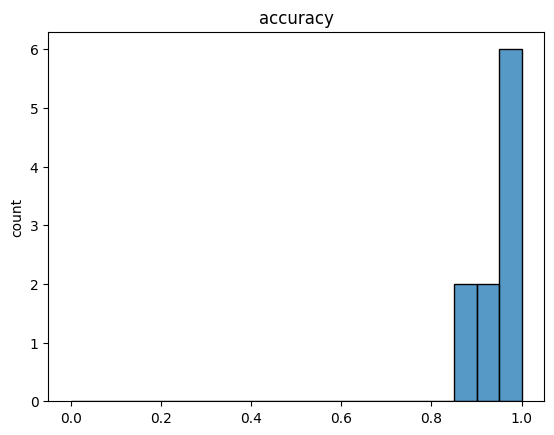
We can also compute additional aggregations or inspect the full list of metrics.
esc_random_forest.agg_metrics_dict(agg_fns=[np.max, np.min])
{'max[accuracy]': 1.0,
'min[accuracy]': 0.8666666666666667,
'max[balancedAccuracy]': 1.0,
'min[balancedAccuracy]': 0.8611111111111112,
'max[geoMeanTrueClassProb]': 0.976458969438705,
'min[geoMeanTrueClassProb]': 0.6379522029160006}
esc_random_forest.get_values("accuracy")
[1.0,
1.0,
1.0,
0.9333333333333333,
1.0,
0.8666666666666667,
0.8666666666666667,
1.0,
1.0,
0.9333333333333333]
Feature Generators and Data Frame Transformers#
When dealing with the preparation of input data for a model, we often need to cater to technical requirements of various types of models. sensAI seeks to make the process of supporting multiple input pipelines for different types of models as simple as possible - by focusing on concise, declarative semantics and integrating the model-specific data extraction and transformation mechanisms into the models themselves. In essence, this means:
Starting with the raw or most general representation of the data
This could mean simply starting with the data that is straightforward for us to obtain - or using directly using particular domain specific objects.
For example, if the problem is to classify situations, we might already have a
Situationclass in our code which represents all the data that is is relevant to a situation (e.g. the point in time, the affected user, the location, etc.). Pandas DataFrames can represent arbitrary data, so there is no reason to not simply use as the raw input data frame that is fed to our models a single column containing instances of classSituation. Or we might instead directly observe a set of sensor readings, all of which are real numbers; this scenario would certainly be closer to what we typically see in machine learning data sets, but it isn’t always the case in the real world.Whatever the case may be, we can represent it in a data frame. We call the original input data frame, which we pass to a sensAI
VectorModel, the raw data frame.Extracing features from the raw data, using their “natural” representation (using
FeatureGenerators)We extract from the raw data frame pieces of information that we regard as relevant features for the task at hand. A sensAI
FeatureGeneratorcan generate one or more data frame columns (containing arbitrary data), and a model can be associated with any number of feature generators. Several key aspects:FeatureGenerators crititcally decouple the original raw data from the features used by the models, enabling different models to use different sets of features or entirely different representations of the same features.
FeatureGenerators become part of the model and are (where necessary) jointly trained with model. This facilitates model deployment, as every sensAI model becomes a single unit that can directly process raw input data, which is (usually) straightforward to supply at inference time.
FeatureGenerators store meta-data on the features they generate, enabling downstream components to handle them appropriately.
The feature representation that we choose to generate can be arbitrary, but oftentimes, we will want to extract “natural” feature representations, which could, in priciple, be used by many types of models, albeit in different concrete forms. Sequential data can be naturally represented as an array/list, categorical data can be represented using descriptive category names, and numeric data can be represented using unmodified integers and floating point numbers.
Transforming feature representations into a form that is suitable for the model at hand (using
DataFrameTransformers)In the transformation stage, we address the model-specific idiosynchrasies, which may require, for example, that all features be represented as numbers (or even numbers within a limited range) or that all features be discrete, that no values be missing, etc. A
DataFrameTransformercan, in principle perform an arbitary transformation from one data frame to another, but the typical use case is to apply transformations of feature representations that are necessary for specific types of models to work (their best).

